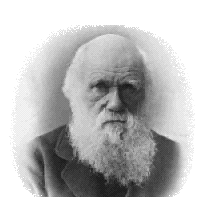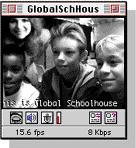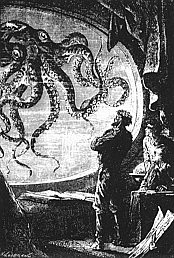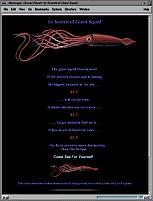Unfortunately, I was at the receiving end as the squid box was lifted out of the truck. The box tipped up in the back, sending a waterfall of giant squid and preservative juice my way. My face and shirt were drenched. So was Clyde's son who was standing next to me. We sputtered, struggled to maintain our balance in the piling snow, then leveled out the box as we carried it to the Jeep. We laughed at how strange it all was. Once the giant squid in its makeshift coffin was lashed to the roof of Clyde's vehicle, we went inside. Champagne was uncorked, a toast was made, and we all hugged our spouses and each other, a round of squid juice for all who hugged us.

Months later, my brother, Ben, working as a summer intern, helped build the display coffin for the giant squid specimen. Little did I know then, how much Clyde's passionate pursuit of the giant squid would greatly influence my classroom of seventh graders.
![]() Spring, 1996
Spring, 1996
The Natural Partners program at the Smithsonian Museum of Natural History
invited me to join teachers from Mississippi in their first tour of the
laboratories and exhibits that are a part of the Natural Partners
program. The idea that scientists might be accessible to teachers and
students via e-mail was very exciting. The aspect of a virtual museum
of digitized museum specimens and artifacts, combined with accessible
expertise that is available to my classroom blew my mind; the possibilities
were endless. With almost a child's giddiness, I privately celebrated:
the future is here!
![]() While on the tour of the warehouse-sized storage
rooms and closet-sized back offices, we came across two standouts.
First was a nationally recognized scientist whose specialty was birds,
who helps the FBI solve murder cases in which the evidence was a few
pieces of broken feathers.
While on the tour of the warehouse-sized storage
rooms and closet-sized back offices, we came across two standouts.
First was a nationally recognized scientist whose specialty was birds,
who helps the FBI solve murder cases in which the evidence was a few
pieces of broken feathers.
 The second surprise occurred when a drawer marked C. Darwin was opened.
With no glass barrier between us, I came
face to feather with well-preserved Finches, caught and tagged in the
Galapagos Islands all those years ago. The handwritten (thereby
autographed) tags on the birds feet are priceless museum pieces in
themselves. That I'm five unprotected inches away from the very birds
that were seen and handled by Darwin -- birds that might have inspired
his theories of natural selection and evolution and thereby change how
humans view their world -- it somehow feels like I've traveled through
time and touched Darwin. In my mind, I'm standing with him on an
island, listening to the ocean crash against beach, holding a finch's
foot so that he can attach an identification tag. I try to remember to
breathe.
The second surprise occurred when a drawer marked C. Darwin was opened.
With no glass barrier between us, I came
face to feather with well-preserved Finches, caught and tagged in the
Galapagos Islands all those years ago. The handwritten (thereby
autographed) tags on the birds feet are priceless museum pieces in
themselves. That I'm five unprotected inches away from the very birds
that were seen and handled by Darwin -- birds that might have inspired
his theories of natural selection and evolution and thereby change how
humans view their world -- it somehow feels like I've traveled through
time and touched Darwin. In my mind, I'm standing with him on an
island, listening to the ocean crash against beach, holding a finch's
foot so that he can attach an identification tag. I try to remember to
breathe.
![]() At the end of my visit, it was suggested that my students and
I hook up with Clyde on his expedition to find live giant squid.
Inspired, I returned to school and convinced my middle school team to
join this pursuit. We were ready.
At the end of my visit, it was suggested that my students and
I hook up with Clyde on his expedition to find live giant squid.
Inspired, I returned to school and convinced my middle school team to
join this pursuit. We were ready.
Fall and Early Winter, 1996
I submitted a request to get a computer in my classroom so my students
and I could follow and communicate with the giant squid expedition team
leaving in January. In the mean time, Clyde agreed to come to my
school and do an evening presentation for my students and the Herndon
community. It was early November when we set the presentation date for
December 2nd. We also agreed to bring 35 students to the
Smithsonian's electronic classroom for a hook-up with a school in
Kentucky.
 Clyde would examine cephalopods with my students while the
Kentucky students looked on via a CU-SeeMe video hook-up over the
phone line. December arrived. My students spent several days putting
up flyers around Herndon and Northern Virginia advertising Clyde's
upcoming presentation and the expedition. The students decided to
serve calamari at the presentation. The mother of a student of mine,
Nick Carr, made several dozen squid cookies in the shape of a giant squid --
eyeball, individual tentacles, and all.
Clyde would examine cephalopods with my students while the
Kentucky students looked on via a CU-SeeMe video hook-up over the
phone line. December arrived. My students spent several days putting
up flyers around Herndon and Northern Virginia advertising Clyde's
upcoming presentation and the expedition. The students decided to
serve calamari at the presentation. The mother of a student of mine,
Nick Carr, made several dozen squid cookies in the shape of a giant squid --
eyeball, individual tentacles, and all.
At Clyde's presentation, we
displayed the details of the expedition using photos from the press
packet, as well as several brochures outlining how people could donate
money to the expedition. Clyde's presentation was a hit. We hoped at
least twenty-five people would come. Imagine our surprise when we
filled almost 300 seats! We thought we'd make at least $100
to give to the expedition team. We made over $700 in ticket
sales. Later, a parent was so taken with Clyde and his work, he had
his company send a check for $500!
 We opened the evening with a video
excerpt of the famous giant squid attack on the Nautilus from Disney's movie
Twenty-Thousand Leagues Under the Sea. Clyde then proceeded to tell
the group about cephalopods, the history and myths of their
investigation, current research, and then all about the expeditions
taking place in '97 and '98. The students prepared questions in advance
and presented them to Clyde. He was mobbed at the end for signatures
and more information. In the students' eyes, Clyde was a true academic
adventurer.
We opened the evening with a video
excerpt of the famous giant squid attack on the Nautilus from Disney's movie
Twenty-Thousand Leagues Under the Sea. Clyde then proceeded to tell
the group about cephalopods, the history and myths of their
investigation, current research, and then all about the expeditions
taking place in '97 and '98. The students prepared questions in advance
and presented them to Clyde. He was mobbed at the end for signatures
and more information. In the students' eyes, Clyde was a true academic
adventurer.
Several careers were launched that night.
![]() The next week, we did the electronic fieldtrip with the Kentucky school video hook-up with Clyde.
The next week, we did the electronic fieldtrip with the Kentucky school video hook-up with Clyde.
![]() It went very well. Parents flooded us with
requests to participate, but we were filled to overflowing.
It went very well. Parents flooded us with
requests to participate, but we were filled to overflowing.
My students handled the specimens and asked questions, as did the Kentucky students. Nick Carr's mother even sent more squid cookies.
![]()
![]() We toured the
specimen preparation areas, the library, and the whole of the
Department of Invertebrate Zoology. The students were pumped, ready to follow the
expedition, which would leave in a few weeks.
We toured the
specimen preparation areas, the library, and the whole of the
Department of Invertebrate Zoology. The students were pumped, ready to follow the
expedition, which would leave in a few weeks.
Just before the winter
holiday, our computer was finally wired for Internet access.
 On that late Friday afternoon, I surfed the Internet and found the
In Search of Giant Squid web page. It was thrilling. This was going to change the
way I taught. I couldn't wait for January!
On that late Friday afternoon, I surfed the Internet and found the
In Search of Giant Squid web page. It was thrilling. This was going to change the
way I taught. I couldn't wait for January!
On the first day back, however, I turned on the computer and found no access to the Internet. Even the Netscape Navigator icon was gone. We were sunk. The computer that took three months to get up and running had crashed, and the expedition would leave in a matter of days. There was no way we could follow the expedition.
![]()
Smithsonian Giant Squid Overview Page
gene carl feldman / gene@seawifs.gsfc.nasa.gov